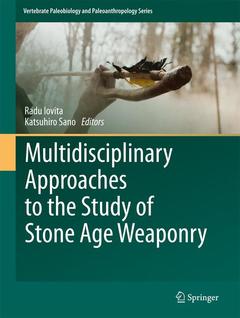Description
Multidisciplinary Approaches to the Study of Stone Age Weaponry, Softcover reprint of the original 1st ed. 2016
Vertebrate Paleobiology and Paleoanthropology Series
Coordinators: Iovita Radu, Sano Katsuhiro
Language: English
Subjects for Multidisciplinary Approaches to the Study of Stone Age...:
Publication date: 06-2016
Support: Print on demand
Publication date: 06-2018
Support: Print on demand
Description
/li>Contents
/li>Biography
/li>Comment
/li>
The objective of this volume is to showcase the contemporary state of research on recognizing and evaluating the performance of stone age weapons from a variety of viewpoints, including investigating their cognitive and evolutionary significance.
Contributions from expert authors are organized into three themed parts: recognizing weapon use (experimental and archaeological studies of impact traces), performance of weapon systems (factors influencing penetration depth etc.), and behavioral and evolutionary ramifications (cognitive and ecological effects of using different weapons).
1 When is a Point a Projectile? Morphology, Impact Fractures, Scientific Rigor, and the Limits of Inference.- Identifying Weapon Delivery Systems Using Macrofracture Analysis and Fracture Propagation Velocity: A Controlled Experiment.- 3 Experiments in Fracture Patterns and Impact Velocity with Replica Hunting Weapons from Japan.- 4 Thirty Years of Experimental Research on the Breakage Patterns of Stone Age Osseous Points. Overview, Methodological Problems and Current Perspectives.- 5 Levers, Not Springs: How a Spearthrower Works and Why it Matters.- 6 Hunting Lesions in Pleistocene and Early Holocene European Bone Assemblages and their Implications for Our Knowledge on the Use and Timing of Lithic Projectile Technology.- 7 Edge Damage on 500-thousand-year-old Spear Tips from Kathu Pan 1, South Africa: the Combined Effects of Spear Use and Taphonomic Processes.- 8 Projectile Damage and Point Morphometry at the Early Middle Paleolithic Misliya Cave, Mount Carmel (Israel): Preliminary Results and Interpretations.- 9 Morpho-metric Variability of Early Gravettian Tanged “Font-Robert” Points, and Functional Implications.- 10 Early Gravettian Projectile Technology in Southwestern Iberian Peninsula: the Double Backed and Bipointed Bladelets of Vale Boi (Portugal).- 11 Uncertain Evidence for Weapons and Craft Tools: Functional Investigations of Australian Microliths.- 12 Projectiles and Hafting Technology.- 13 Testing Archaeological Approaches to Determining Past Projectile Delivery Systems using Ethnographic and Experimental Data.- 14 Penetration, Tissue Damage, and Lethality of Wood- VersusLithic-Tipped Projectiles.- 15 Experimental and Archeological Observations of Northern Iberian Peninsula Middle Paleolithic Mousterian Point Assemblages. Testing the Potential Use of Throwing Spears among Neanderthals.- 16 More to the Point: Developing an Multi-Faceted Approach to Investigating the Curation of Magdalenian Osseous Projectile Points.- 17 Survivorship Distributions in Experimental Spear Points: Implications for Tool Design and Assemblage Formation.- 8 Morphological Diversification of Stemmed Projectile Points of Patagonia (Southernmost South America). Assessing Spatial Patterns by Means of Phylogenies and Comparative Methods.- 19 Hunting Technologies during the Howiesons Poort at Sibudu Cave: What They Reveal about Human Cognition in KwaZulu-Natal, South Africa, between ~ 65 and 62 ka.- 20 Summary and Conclusions.

